

Most ebook files are in PDF format, so you can easily read them using various software such as Foxit Reader or directly on the Google Chrome browser.
Some ebook files are released by publishers in other formats such as .awz, .mobi, .epub, .fb2, etc. You may need to install specific software to read these formats on mobile/PC, such as Calibre.
Please read the tutorial at this link: https://ebookbell.com/faq
We offer FREE conversion to the popular formats you request; however, this may take some time. Therefore, right after payment, please email us, and we will try to provide the service as quickly as possible.
For some exceptional file formats or broken links (if any), please refrain from opening any disputes. Instead, email us first, and we will try to assist within a maximum of 6 hours.
EbookBell Team

4.4
42 reviewsThis book introduces the reader to the field of jet substructure, starting from the basic considerations for capturing decays of boosted particles in individual jets, to explaining state-of-the-art techniques. Jet substructure methods have become ubiquitous in data analyses at the LHC, with diverse applications stemming from the abundance of jets in proton-proton collisions, the presence of pileup and multiple interactions, and the need to reconstruct and identify decays of highly-Lorentz boosted particles. The last decade has seen a vast increase in our knowledge of all aspects of the field, with a proliferation of new jet substructure algorithms, calculations and measurements which are presented in this book.
Recent developments and algorithms are described and put into the larger experimental context. Their usefulness and application are shown in many demonstrative examples and the phenomenological and experimental effects influencing their performance are discussed. A comprehensive overview is given of measurements and searches for new phenomena performed by the ATLAS and CMS Collaborations. This book shows the impressive versatility of jet substructure methods at the LHC.